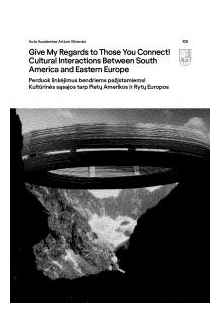- Titulinis
- Meno ir laisvalaikio literatūra
- Menas
- Menai: bendrieji dalykai
- Perduok linkėjimus bendriems pažįstamiems! (Acta Academiae Artium Vilnensis 105)
Perduok linkėjimus bendriems pažįstamiems! (Acta Academiae Artium Vilnensis 105)
Leidimo metai: 2022
Leidėjas: Vilniaus dailės akademija
Puslapių skaičius: 320
Leidinio kalba: Lietuvių
Formatas: Minkšti viršeliai
This collection of texts covers a wide historical period spanning from the 17th to 21st centuries. The authors show how, over a range of historical periods, the religious festivities (Rūta Janonienė), art shows and world fairs (Lena Trüper, Karolina Jakaitė), art criticism and artistic networks (Katarzyna Cytlak), and literary translations (Krzysztof Siatka) became certain ‘contact zones’ for the emergence and development of cultural interactions between South America and Eastern Europe. They also show what interfered with these interactions, and the images these individual countries had developed. In line with the problematic of connections, the volume features articles on mobility of images (Sigita Maslauskaitė-Mažylienė), transcontinental artistic migration (Laura Pertauskaitė), and the inter-textuality of modern poetry (Dovilė Kuzminskaitė). The authors also discuss the role of orientalist imagination in the construction of the South American and Eastern European identities (Gražina Bielousova), and rethink the impact of coloniality for art canons (Bart Pushaw).
The volume traces the connections not only between the different geographical and problematic contexts, but also between the researchers from Uruguay/Slovakia, Poland/Argentina, Lithuania/USA, USA/Denmark, Germany/USA, Poland and Lithuania. However, the initial aim of equal input from the researchers of South America and Eastern Europe remained unachieved. The challenges that arose during the editorial process have only confirmed the fact that both the topic itself and the connections between the scholars from both regions are still in the early formative stages, and thus require further efforts and developmental initiatives. Furthermore, there is a shortage of researchers who specialise in these regional contexts and are consistently working in this area. I hope that this volume will bring attention to the problematic of relations between the South American and Eastern European cultures, and serve as an impetus for the researchers to develop it further.
--------------------------------------------------------
Straipsnių rinkinys apima platų istorinį laikotarpį – nuo XVII iki XXI amžiaus. Autoriai atskleidžia, kaip įvairiais istoriniais tarpsniais vykusios religinės iškilmės (Rūta Janonienė), dailės parodos ir pramonės pasiekimų mugės (Lena Trüper, Karolina Jakaitė), dailės kritikos tekstai ir menininkų tinklai (Katarzyna Cytlak) bei literatūros vertimai (Krzysztof Siatka) tapo „kontaktinėmis zonomis“, susiejusiomis Pietų Ameriką ir Rytų Europą, kokie buvo komunikacijos trikdžiai ir kokie atskirų šalių įvaizdžiai formavosi. Ryšių problematiką papildo vaizdų sklaidai (Sigita Maslauskaitė-Mažylienė), transkontinentinei dailininkų migracijai (Laura Petrauskaitė) ir modernios poezijos intertekstualumui (Dovilė Kuzminskaitė) skirti straipsniai. Lygiagrečiai aptariamas orientalistinės vaizduotės vaidmuo, konstruojant Pietų Amerikos ir Rytų Europos tapatybes (Gražina Bielousova), permąstoma šių regionų kolonizacijos istorija ir su ja susiję dailės kanonai (Bart Pushaw).
Straipsnių rinkinys susieja ne tik skirtingus geografinius ir probleminius kontekstus, bet ir skirtingoms šalims atstovaujančius tyrėjus iš Urugvajaus / Slovakijos, Lenkijos / Argentinos, Lietuvos / JAV, JAV / Danijos, Vokietijos / JAV, Lenkijos ir Lietuvos. Pradinio sumanymo, kad Pietų Amerikos ir Rytų Europos tyrėjų indėlis į sudaromą leidinį būtų lygiavertis, pasiekti nepavyko. Kilę iššūkiai patvirtino, kad tiek pati tematika, tiek abiejų regionų mokslininkų ryšiai dar yra neišsiplėtoję ir reikalauja tolesnių pastangų ir iniciatyvų. Be to, trūksta tyrėjų, puikiai išmanančių abiejų regionų kontekstus ir nuosekliai dirbančių šioje srityje. Tikiuosi, kad šis Acta Academiae Artium Vilnensis numeris padės aktualizuoti Pietų Amerikos ir Rytų Europos kultūrinių sąveikų problematiką ir paskatins tyrėjus ją toliau plėtoti.

